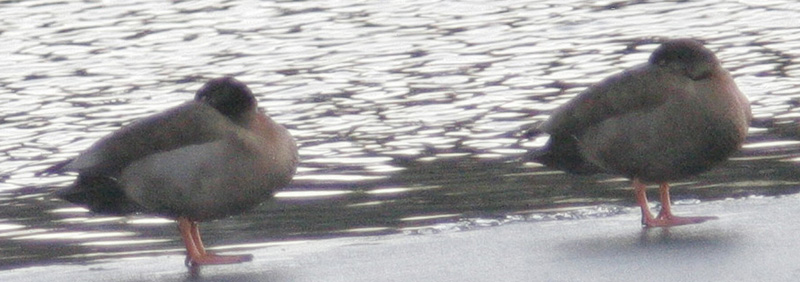




It is not at all clear whether the birds are of different or same sex.
The following fieldmarks were noted in the field and are also findable from
the photographs.
The birds did not fly a single time
Size:
While sitting on the edge of the ice, the birds appeared larger than the
adjacent mallards, but this was possibly due to the higher feet. The body
seemed in size quite similar to a mallard or at the most just slightly
larger. They were defintely not smaller than mallards.
Bare parts:
Eyes dark.
Feet orange, obviously longer than Mallards'.
Bill broad, but rather thin vertically in the outer half.
The base 2/3 of the bill black, and the tip 1/3 orange. The very tip (=nail)
black.
Notes about the plumage:
The plumage of one of the birds is tidier.
Undertailcoverts + rear end of the belly black.
The exact color of the greyish/brown toned mantle/back difficult to describe.
The visible tips of the primaries paler.
The closed wings shows a narrow white streak (edge of the speculum?).
Flanks paler than the mantle, "dusky"/"dirty".
The breast had a tone of dark violet(/copper).
Neck and head rather dark. Both birds had pale spots behind the eye.
Around the crown some iridiscent shine, which appeared sometimed greenish,
sometimes coppery and sometimes violet. The color tones reminded me of
the Swedish
Red-crested Porchard x Wigeon .
General tone of the bird quite dark.
The first photograph suggests that the bird on the left shows some checkered
patterns (feathers with pale edges?) on the mantle.
Where does the red in the bill come from? Red-crested Porchard, Red-breasted Merganser (Mergus serrator), Black-bellied Whistling Duck (Dendrocygna autumnalis), Wood Duck (Aix sponsa). I'm banging my head into the wall.
The Swedish bird (linked above) shows some characters similar to our bird (coloration of rear parts, head spots, the iridiscence of the breast and head, although these are stronger with the swedish bird). Could these birds be male Red-crested Porchard x Wood Duck hybrids?
Ei ole kovin ilmeistä ovatko linnut samaa vai eri sukupuolta.
Seuraavat tuntomerkit havaitsin maastossa ja näen ne valokuvissakin.
Linnut eivät lentäneet kertaakaan.
Koko:
Linnut vaikuttivat jäällä sinisorsaa isommille, mutta johtui ilmeisesti
korkeammista koivista. Linnun kroppa näytti sinisisorsan kokoiselle tai
enintään hiutusen isommalle. Selvästi sinisorsaa pienempiä ne eivät
olleet. Vertailun vuoksi ks viimeinen kuva.
Paljaat osat:
Silmät tummat
Koivet oranssit, selvästi pidemmät kuin sinisorsalla, nokka leveä mutta kärkipuoliskosta varsin matala
Nokka tyvi 2/3 musta ja kärki 1/3 oranssi. Aivan kärki (=kynsi) musta.
Huomioita höyhenistön varistä:
Toinen lintu oli "puhtaamman" värinen
Alaperä musta.
Selkä vaikeasti kuvattavan harmaan/ruskean sävyinen, käsisulkien näkyvät kärjet vaaleammat
Suljetuissa siivissä ohut valkea raita (siipipeilin reunaviiva?)
Kupeet vaaleammat kuin selkä, "tahraiset"
Rinta tumma violettin(/kuparin?) kaltaista sävyä.
Kaula ja pää tummia. Molemmilla linnuilla silmän takana vaaleita täpliä.
Päälaen seudulla hohtoa, joka näytti välillä vihertävälle, välillä
kuparille tai violetille. Sävystä tuli mieleen Ruotsin Hjon
Narskuxhaapanan sävyt.
Yleisväri kovin tumman puoleinen.
Ekassa kuvassa vasemmanpuoleisen linnun yläselässä näyttää olevan hieman
ruutumaista kuviointia (vaaleat höyhenten reunat?
Mita tullut mieleen nokan punaisesta.. Narsku, Tukkakoskelo, Dendrocygna autumnalis (Black-bellied Whistling Duck). Revi siitä sitten.
Yllälinkitettyyn Hjon lintuun nähden on joitakin saman suuntaisia piirteitä (takapään väri, pään täplät, rinnan ja paan hohdot, jotka tosin ruotsalaisella paljon voimakkaammat). Voisivatkohan nämä linnut olla punapäänarsku x morsiosorsa koiraita?





Last update: April 8, 2006